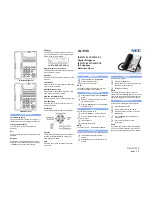
Call Features
358
Dial Plan Defined by Digit Map (New Dial Plan Mechanism)
Digit maps, described in
, are defined by a single string or a list of strings. If a number entered matches
any string of a digit map, the call is automatically placed. If a number entered matches no string - an impossible
match - you can specify the phone’s behavior. You can specify the digit map timeout, the period of time before the
entered number is dialed out.
Topics
Basic Regular Expression Syntax for Digit Map
Digit Map for All Lines Configuration
Digit Map for a Specific Line Configuration
Basic Regular Expression Syntax for Digit Map
You need to know the following basic regular expression syntax when creating a new dial plan:
T
The timer letter “T” indicates a timer expiry. If “T” is used alone (for example, 123T), the default timeout
value of 3 will be used. If “T” is not used alone (for example, 123<Tx>, x can be a digit from 0 to 99), a
complete match occurs when waiting x seconds after inputting 123.
x
The “x” can be used as a placeholder for any digit from 0 to 9.
Example:
“12x” would match “121”, “122”, “123”, and so on.
[]
The square bracket "[]" can be used as a placeholder for a single character which matches any of a set
of characters. Example:
"91[5-7]1234" would match “9151234”, “9161234”, “9171234”.
-
The dash “-” can be used to match a range of digits within the brackets.
Example:
“[35-7]” would match the number “3”, “5”, ”6” or ”7”.
Note: The digits must be concrete, for example, [3-x] is invalid.
.
The dot “.” can be used as a placeholder or multiple placeholders, including zero, of occurrences of the
preceding construct.
Examples:
“123.T” would match “123”, “1233”, “12333”, “123333”, and so on.
“x.T” would match an arbitrary number.
“[x*#+].T” would match an arbitrary character.
Note: If the string ends with a dot (for example, 123.), a match will occur immediately after inputting the
characters before the dot (e., 123) since the dot allows for zero occurrences of the preceding construct.
Therefore, we recommend that you add a letter “T” after the dot (for example, 123.T) for inputting more
characters.
R
The letter “R” indicates that certain matched strings are replaced. Using an RRR syntax, you can
replace the digits between the first two Rs with the digits between the last two Rs. Example:
“R12R234R” would replace 12 with 234.
<:>
The letter “:” in the angle bracket indicates that certain matched strings are replaced. Using the <:> syn-
tax, you can replace the digits before the colon with the digits after the colon.
Example:
“<12:234>” would replace 12 with 234. It is the same with R12R234R.
!
The exclamation mark “!” can be used to prevent users from dialing out specific numbers. It can only be
put last in each string of the digit map.
















































